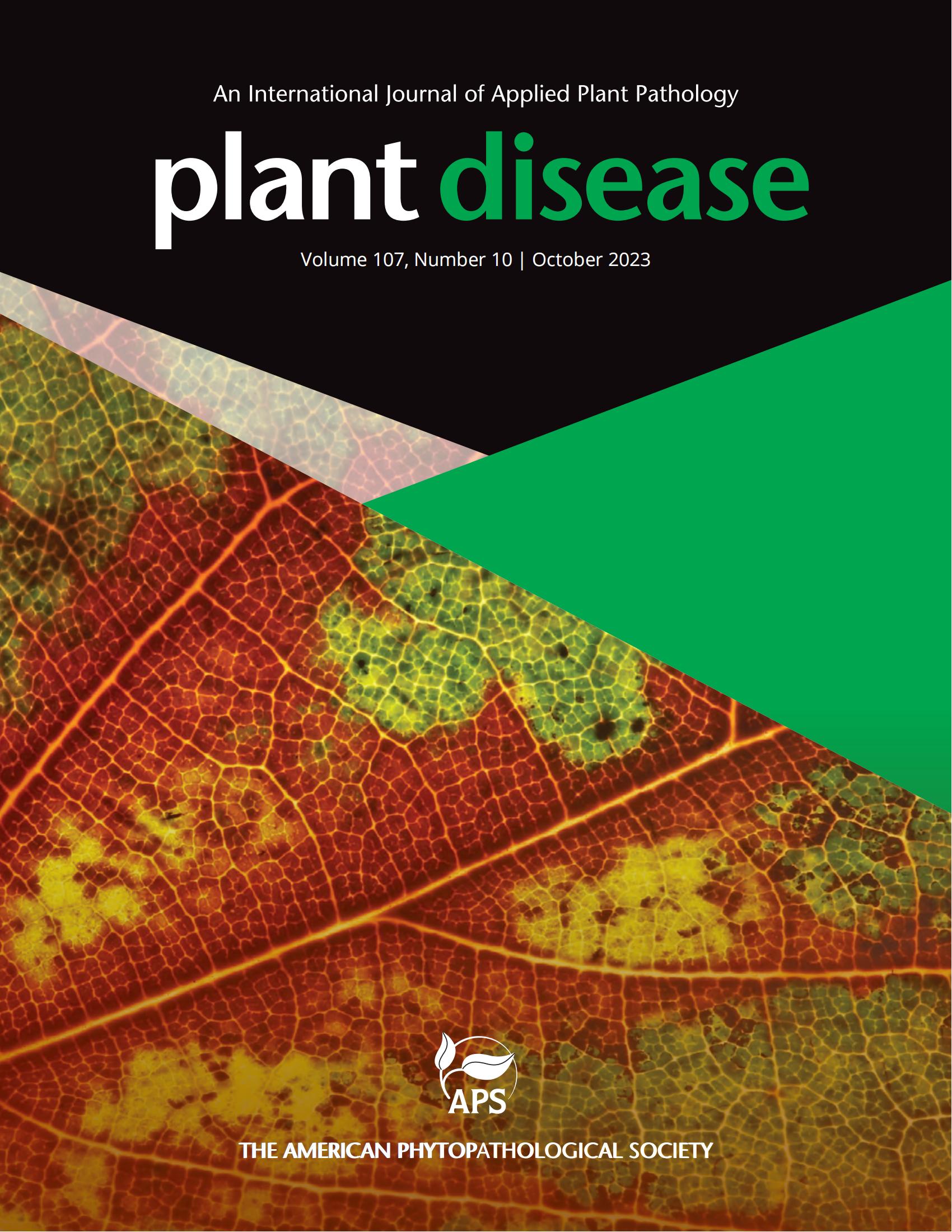中国首次报告 Rugonectria rugulosa 导致 "Banbianhong "水杨梅枯萎。
摘要
板蓝根(Prunus salicina)是中国西南地区栽培的一种名贵水果作物,因其果实品质高,经济效益可观(Wang 等,2021 年)。2023 年 7 月,云南省昭通市绥江县的板边红出现了枯梢病,发病率高达 10%。该病使染病植株皮层出现褐色结节,导致干裂,露出灰褐色木质部,使植株枯死。纵切小枝后,病变明显,其特征是茎束和组织内的髓部变褐、坏死。将病变组织切成 2 平方毫米的小块,用 70% 的乙醇和 1% 的 NaClO 进行表面消毒,然后用双蒸水冲洗。将组织碎片培养到马铃薯葡萄糖琼脂(PDA)上,在 28°C 下培养 7 天。共获得 6 个分离株,其中两个分离株(WG2-1 和 WG2-3)被选中进行形态学、分子鉴定和致病性测试。在 PDA 上,WG2-1 和 WG2-3 的菌落直径分别为 5.50±0.56 毫米/天和 6.08±0.37 毫米/天。两种分离物的微菌丝均为零隔、光滑、带绿色、近球形至椭圆形,大小为 5 至 10 × 1.5 至 3 µm(n = 50)。不过,没有观察到大锥体。使用引物对 ITS1/4(White 等,1989 年)和 Bt2a/2b(Glass 和 Donaldson,1995 年)扩增了内部转录间隔 rDNA(ITS)和 β-微管蛋白 2(TUB2)基因。对所获得的 ITS 序列(登录号:PP581792)和 TUB2 序列(登录号:PP2815212)进行 BLAST 分析表明,它们与 Rugonectria rugulosa(ITS 的登录号为 MG991753,TUB2 的登录号为 KM232007)具有 100%的相同性。根据这些特征,分离物被鉴定为 R. rugulosa,并保存在云南省农业科学院农业环境与资源研究所植物病原菌实验室。在本研究中,为了完成科赫假设,对一年生的水杨梅 "板边红 "树枝进行了致病性试验。用 1 毫米的无菌木塞钻头将树枝刺伤,然后接种分离株(WG2-1)的 14 天菌丝塞,并用密封薄膜覆盖。将无菌 PDA 塞放入对照树枝的伤口中。18 根健康的小枝接种了分离株或 PDA 插条(n = 6 根小枝/处理,小枝大小:长 8 厘米,直径约 0.7 厘米,3 次重复),并与湿滤纸一起分别放入 28°C 恒温培养箱(型号,HYC-260)中的密闭无菌托盘中。接种了分离物的树枝在接种部位出现褐色病变,而对照组则没有症状。通过上述方法,成功地从病变部位重新分离出了 R. rugulosa,但没有从对照组的伤口中分离出 R. rugulosa。据报道,R. rugulosa 与中国 Falcataria moluccana 的枯萎病有关(Wang 等,2019 年)。R. rugulosa 在绥江县水杨梅 "板边红 "种植区的发生和传播造成了严重的经济损失。据我们所知,这是 R. rugulosa 引起 "板边红 "水蜜桃枯死病害的首次报道。这些结果证实了褐斑病菌在 "板边红 "水蜜桃中的致病性,为制定病害防治策略提供了有价值的启示。Banbianhong (Prunus salicina) is a valuable fruit crop cultivated in the southwestern regions of China for its high quality fruit and substantial economic benefits (Wang et al. 2021). In July 2023, dieback disease was observed in Banbianhong in Suijiang County, Zhaotong, Yunnan Province, with an incidence of up to 10%. The disease caused brownish nodules in the cortex of the infected plant, leading to dry cracking, and exposing grayish-brown xylem, which caused the plant to wither and die. Upon longitudinal cutting of twigs, lesions were evident and characterized by browning and necrosis of the cauline bundle and pith within the tissue. The diseased tissues were sectioned into 2 mm2 pieces and surface disinfected with 70% ethanol and 1% NaClO and rinsed with double distilled water. The tissue fragments were plated onto potato dextrose agar (PDA), and incubated for 7 days at 28°C. A total of six isolates were obtained, and two isolates (WG2-1 and WG2-3) were selected for morphological, molecular identification and pathogenicity testing. On PDA, the colony diameter of WG2-1 and WG2-3 were recorded as 5.50±0.56 mm/day and 6.08±0.37 mm/day, respectively. The microconidia of both isolates were zero-septate, smooth, greenish, subglobose to ellipsoidal, and measured 5 to 10 × 1.5 to 3 µm (n = 50) in size. However, macroconidia were not observed. The internal transcribed spacer rDNA (ITS) and β-tubulin 2 (TUB2) genes were amplified using the primer pairs ITS1/4 (White et al. 1989) and Bt2a/2b (Glass and Donaldson 1995). BLAST analysis of the obtained ITS sequences (accession Nos. PP581792) and TUB2 sequences (accession Nos. PP2815212) sequences showed 100% identity with Rugonectria rugulosa (accession nos. MG991753 for ITS and KM232007 for TUB2). Based on these characteristics, the isolates have been identified as R. rugulosa and have been deposited in the Agricultural Environment and Resource Research Institute plant pathogen lab at Yunnan Academy of Agricultural Sciences. In this study, Pathogenicity tests were conducted on one-year-old Prunus salicina "Banbianhong" twigs to complete Koch's postulates. The twigs were wounded using a 1-mm sterile corking borer and 14-day-old mycelium plugs of isolate (WG2-1) were inoculated and covered with sealing films. Sterile PDA plugs were placed into the wounds of control twigs. Eighteen healthy twigs were inoculated with isolates or PDA plugs (n = 6 twigs/treatment, the size of the twigs: 8 cm length and diameter about 0.7 cm, with three replications) and were placed in a closed sterile tray with the wet filter papers in a thermostatic incubator (type, HYC-260) at 28°C, respectively. The twigs inoculated with the isolates exhibited brown lesions site of inoculation, whereas the controls remained asymptomatic. R. rugulosa was successfully reisolated from the lesions but not from these control wounds and was identified by the methods described above. R. rugulosa has been reported to be associated with the die-back disease of Falcataria moluccana in China (Wang et al. 2019). The occurrence and spread of R. rugulosa in growing areas of Prunus salicina "Banbianhong" in Suijiang county have caused severe economic losses. To our knowledge, this is the first report of the die-back disease of Prunus salicina "Banbianhong" caused by R. rugulosa. These results confirm the pathogenicity of R. rugulosa in Prunus salicina "Banbianhong" and provide valuable insights for developing disease management and prevention strategies.

 求助内容:
求助内容: 应助结果提醒方式:
应助结果提醒方式:


